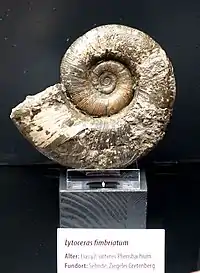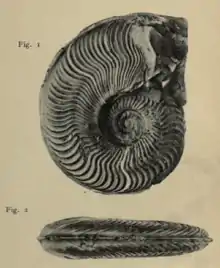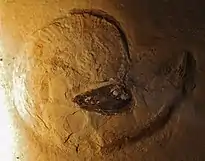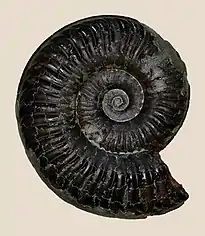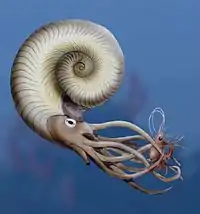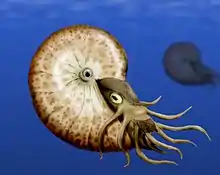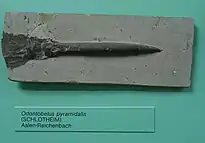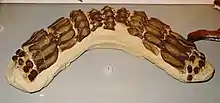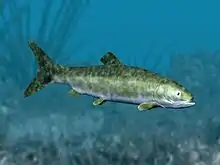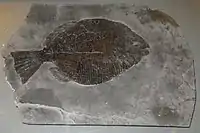Sachrang Formation
The Sachrang Formation is a geological formation in Austria and Germany, dating to about 180 million years ago, and covering the lower and middle Toarcian stage of the Jurassic Period.[1] It is among the most important formations of the Toarcian boundary in the Northern Alps realm, being the regional equivalent of the Posidonia Shale.[2] The Sachrang Formation is included inside the major stratigraphic groups found on the Tirol Mountains in Central Europe, where is equivalent to the Saubach Formation, also from the Toarcian stage.[3] It is part of the series of formations with the presence of Toarcian black shales, being among the most important of the Alpine-Mediterranean domain.[3] Those Shales on the Northern Calcareous Alps was sedimented based on a strong dependency on the overall palaeobathymetric situation of the region, as recovered by the microfacies types as well as in the composition of the biota.[1] The deeper part is domain of the Sachrang Shales, with a basin radiolaria-rich lithologies, and a parallel series of submarine topographic highs a dominance of echinoderm-and mollusc-biomicrites (Unken Shales) and a strong increase in resedimentation can be observed.[1]
| Sachrang Formation Stratigraphic range: Lower-Middle Toarcian ~180 Ma | |
|---|---|
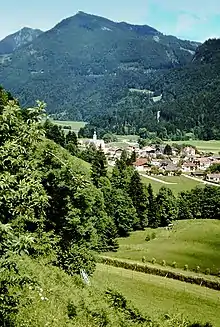 Sachrang, Southern Germany, where the Main strata of the formation was first described | |
| Type | Geological formation |
| Sub-units |
|
| Underlies | Klaus Formation |
| Overlies | Allgäu Formation |
| Thickness | 15–27 m (49–89 ft) |
| Lithology | |
| Primary | Bituminous Marls |
| Other | Basal Mudstone and carbonate Debrite |
| Location | |
| Region | Bavaric Nappe-Northern Tirol |
| Country | |
| Type section | |
| Named for | Sachrang, a location in Southern Germany |
| Named by | Jacobshagen |
| Year defined | 1965 |
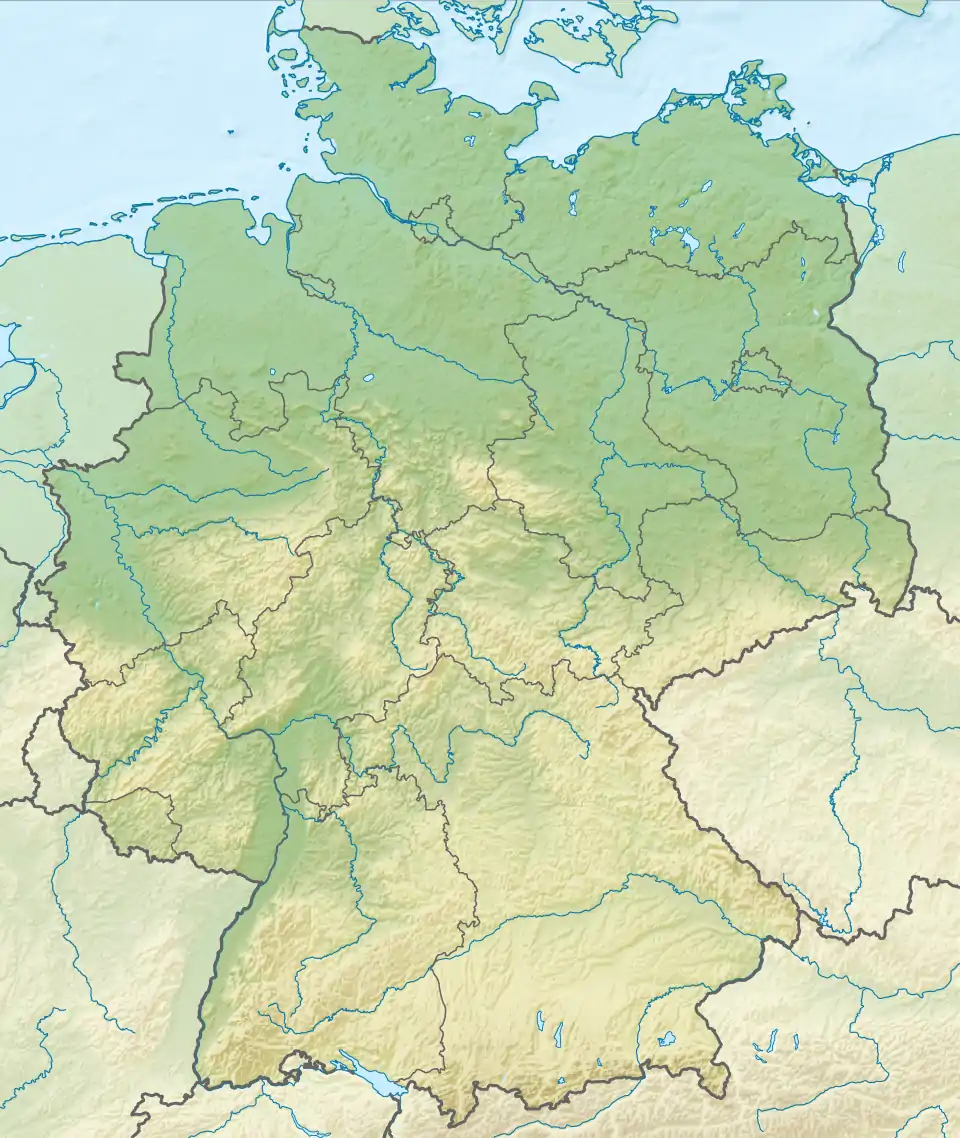 Sachrang Formation (Germany) | |
Geology
The Jurassic sedimentation is subdivided on several different units, with drastic changes in the Northern Calcareous Alps. During the Toarcian, carbonate platforms collapsed and several types of bottom reliefs where generated due to tectonic activity, where on the submarine swells the red nodular limestones with an exposure of 20 m of the Adnet Formation were deposited on zones of basinal sedimentology, know due to the presence of grey limestone and marl on an up to 200 m layer of the Allgäu Formation.[3] The marls of the Sachrang Formation are part of the Lower Toarcian "Black Shale deposition", contemporaneous of other events on central Germany and England.[3] The Sachrang Formation was geologically divided in the Sachrang Member, that presents typical development of a basinal area and the Unken Member, with benthic microfossils with suboxic water influence.[3] The Toarcian Black Shale of the Sachrang Formation are related to the ones present on the Úrkút Manganese of Hungary, that is related with manganese ores that develop over more than 250 km distance in the Northern Calcareous Alps.[4] All the units where vinculated to the Transdanubian Range Unit, where the Sachrang Formation and the Úrkút Manganese shared the paleogeographic evolution present on the southern near land margin, influenced by a continuous process of Rifting present on the Tethys Ocean.[4] On the Hettangian the vinculated central European platforms drowned and where affected by Sinemurian-Pliensbachian tensional tectonic events along with marine sedimentation, reoriented by the emersion of horsts on the Úrkút area.[4] The Pliensbachian basin had near 200 m depth, and the presence of slope environments, tectonically influenced basins are indicated on locations such as the Hiertlaz Limestone.[5] The marine sedimentation and the continuous tectonic rework let some of the local basins to last until the latest Jurassic.[5] In the Toarcian, there was a great condensation affecting the subsided highs, where ferric components where deposited. After that, tectonics, faulting and erosion on the Cretaceous change the deposition of the region.[5]
Stratigraphy
The Sachrang Formation is composed by various levels, starting with a lover level of basal mudstone of 4 m thick.[6] This level is composed mainly by organic filled layers that have some hiatus, occupied by continental-derived deposition. Over the mudstone level, a series represented by the Bächental bituminous marls and a Debrite is exposed. The lower part of this section is composed by greyish marls, with abundant radiolarians, bivalves of the genus Bositra, ostracods, sponge spicules, and some Foraminifera. Samples from Unit 2 show varying microfacies.[6] The stratification of the Bächental level presents a trend of marine to mesosaline conditions, as it was part of a depocenter at the south of the path between the Bohemian Massif & the Vindelician land.[7] Some of the layers at that locality expose also influence of temporal hypersaline conditions on bottom waters, due to the abundance of methylsteranes, associated with Dinoflagellates or halophylic microorganisms and gammacerane. This salinity stratification might have had an impact on the presence of organic matter on the level.[7]
Sachrang Shales
The Sachrang Shales where cited originally on the reestudy of the Alpine Upper Black Slate, composed with dark gray, somewhat sandy, disintegrating into thin but large plates of Marl.[8] Other studies where recovering a Greenish-Gray Marl Slate levels,[9] Black Marl limestone on the Midlle Toarcian Levels,[10] a dominant level of bituminous marl[11] and the high presence of dark brown manganese slates, that many of the Early works compare these deposits with the Posidonia Shale in southern Germany.[12] until the point that there are works that put the at Sachrang Black Shale under the name Posidonia Shale.[13] The definition of the Sachrang Shales has been convoluted along its history of study of the location, where there are works of the North Alpine Mesozoic that prefer before calling these deposits Sachranger Shale to give it a brief different diagnosis.[14] On the Unken Syncline near Lofen, basinal deposits with abundant Aragonite and Calcite helped to know the major Jurassic basin geometry, where on several layers of the same age was complicated due to the posterior Alpine deformation.[15] Correlated Unken and Diessbach basins developed mostly during the Toarcian, with deposition of abundant material from the near Emerged Landmasses.[15] On the Unken Syncline, the breccias associated with the normal faults were deposited until Oxfordian age.[15]
Bächentaler Bitumenmergel
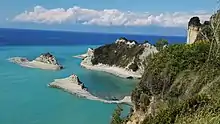
The Bächental bituminous marls consists of a 24-m-thick succession of bituminous marls in the Bächental valley of Tyrol, that recovers a marginal Marine Basin, where the major Toarcian Events where recorded, with paleoenvironmental changes within the Bächental basin, as recovered by the study of Organic Matter accumulation influenced by the global (Magmatism, opening of the Alpine Atlantic Ocean) and local scales s (Basin morphology, salinity variations).[16] There is not clear whether the Sachrang Shale includes or not all the Iithological type of the "Bächental layers", while subject to the most recent results.[1] "Bächental layers" had recover the influence from the Hungarian Volcanic events that took place during the Lower Toarcian, as was located on the NW continental margin of the Neotethys Ocean and the SW continental margin of the Alpine Atlantic.[17] Also, the occurrence of considerable amounts of Smectite through the entire Sachrang Formation suggests continuing local inputs from volcanic sources.[17] In the Toarcian this area was located on the northwestern continental margin of the Neotethys Ocean and the southeastern of the new passive margin of the Alpine Atlantic.[16] The Sachrang Formation on this Valley is dominated by the Bächental bituminous marls, with a level of 0.25-m basal Mudstone (with Quartz and clay minerals of terrigenous origin), followed by a 1.00-m-thick Debrite layer.[16] There is also abundant charred organic material along with the Smectite that show that the volcaniclastic contribution of the sediment may have triggered the onset of OM accumulation in the Bächental basin.[16] Smectite is also common on the other sections of the formation, suggesting continued influx of volcaniclastic material.[16] The Toarcian Oceanic Anoxic Event is well recorded on this section, where as throughout the Mediterranean area and the northeastern West Tethys Shelf depositional conditions in general did not favor preservation of organic matter with low concentrations of Total Organic Matter.[7] Also connects with the same age strata from the Réka Valley.[7] Extensive bioturbation and relatively low Total Organic Content are indicative of normal-marine conditions without major perturbations of the carbon cycle during deposition of the Scheibelberg Formation and the Schrang Formation.[18] Although several redox changes affected the depositional environment of the Bächental bituminous marls, where Suboxic to possibly short-term anoxic conditions prevailed during deposition of several of the units.[18]
Lithology

The Sachrang Formation is composed mostly by marine depositional components, where the black shales are the main part of the strata present, with a major composition of bacterial origin (as is present on the Marne di Monte Serrone). The Sachrang Shale represent blackish gray to dark brown bituminous, fine-leaved, somewhat sandy marl slate, that lies on the profile of the strata, alternated with storage light brown (max. 4 mm) and darker layers (rarely over 2 mm) characteristic.[14] The ligther layers present the rock gets darker while keeps its fine-plate character.[14] The Shale has a Dark-Gray to brownish tone, alternated with more rarely light gray shades.[1] There is a relatively common presence of blue fittings, as well as Wood and Fish remains (Bones, scales).[14] The younger strata with the fresh outcrops develops on a series of several meters thick wall, that splits into fine paper Slates when weathered.[14] The Slate is among the most common mineral on the strata, with an average lime content of 40.2%, where maximum values are at 58% and minimum values at 26%.[14] Bituminous Claystones are present in the Edge facies of the Sachrang Shale (="Unken Shales"), with green Clay march engagements.[14] There is not clear separation between "Manganese Shale" and "Bituminous shale" in the main localities of the formation, because the Bituminous content fluctuates with the manganese contents, that is always high.[2] The Unken Shales on the Bächental locality is layered on a major Silicate component of the 60% with a pronounced dominance of Illite, along with a significant amount of Montmorillonite.[1] The presence of Quartz and Calcite is relative with other locations of the same region from also the Toarcian, while the Pyrite content is also consistently high. Finally, the Unken Shale samples also show minor levels of Dolomite and Feldspar.[14] There is a great abundance of Foraminiferans and Coccoliths.[19] Dinoflagellates are the major organic component and the most abundant microfossils.[3] Manganese is present, such as in the Toarcian deposits of Hungary.[20] The formation has a laminate Shale horizon associated with the Manganese Ores, with a transition of siliceous limestones and marls to black shales. Those are completed by the marl levels, composed by lithoclasts. quartz and smectite are the main minerals, along with illite, chlorite, and plagioclase in minor amounts. Bächental bituminous marls consist mainly of quartz and carbonate minerals.[6] Isorenieratene derivatives are highly abundant on this level, related to several processes such as sedimentary iron, influenced by anoxic conditions.[21] Rhodochrosite and maganese rich calcite are present in the manganese levels, while the Black Shale levels are rich in Pirite.[3] The lower matrix is composed by clay and carbonate minerals, such as muscovite and feldspar. The presence of altered Celadonite, suggest volcanogenic solutions as the most probable source, where the high amounts of dissolved manganese of continental origin was translated to the epicontinental margins of the Tethys.[6] On the Bächental bituminous marls had a bulk mineralogy where the Calcite is the most abundant fraction (49%), followed by Phyllosilicates (35%), Quartz (11%) and Pyrite (5%).[22] While the Clay mineral distribution includes a large amount of Illite (51%), Montmorillonite (40%) and Kaolinite (9%).[22]
Manganschiefer
The so-called "Manganschiefer" recovers a great part of the Toarcian Bavaric Nappe, being a series of deposits with dominant Magnese Shale, that preserved different kind of fossils, from Ammonites to Fish.[23] The deposits of nodule formation to submarine volcanism present on the "Manganschiefer" are related with occurrences on Sicily.[24] The local manganese mineralization is constituted predominantly of carbonate mineral phases, being the two main A Magnesium-poor paragenesis with association with Calcite, with or without Dolomite, alternated with a Mn-rich one with high presence of calcite, along with Kutnahorite, and Carbon rich Rhodochrosite.[25] Associated, there is a series of secod manganese minerals such as Pyrolusite, Manganite, and a lesser presence of Birnessite and Todorokite, that appear in Rhodochrosite-dominated samples.[25] On several places a manganese ore horizon goes up to a 1 m, for example on Pürzlbach to the Kallbrunnalm.[26] At Salzburg there is an horizon made of solid Manganese ore along a deposited few dm of polymictic and poorly sorted breccia.[26] The breccia is composed by angular fragments of at least 7 cm large of manganese Schist and Manganese ore, but also Dachstein Limestone pebbles.[26] The Dachstein limestone blocks are composed of masses of ammonites and up to several cm in size Crinoids, that are Fe/M impregnated.[26] Other Biota include abundant Echinoderm Remains. Finally, on the Dachstein Limestone in the form of a poorly washed out Pelparites follows first a few mm thick, possibly due to cyanobacteria, precipitated Fe/Mn crust.[26] The Manganschiefer on the Sachrang Formation consists of the lower part with gray to beige-gray Marl; fine laminated Marl, partly with Pyrite and manganese minerals; dark gray, carbonate Siltstones, partly ransacked; alternating reddish and yellowish Laminites, insignificant; fine-grained layers of Breccia;Slumping horizons.[26][27] The in depth mineralogy revelated that along the manganese oxides of a thin weathering crust (Pyrolusite and Todorokite) there are carbonates (System CaC03-MnC03-FeC03-MgC03) and small amounts of the silicate Braunite (Syngenetic Braunite, that is directly related to warm or hot waters).[24] The local manganese minerals are characteristically associated with several Iron minerals. Rhodochrosite, Siderite, Chamosite along with sulfides, mainly Pyrite and rarely Marcasite, are abundant in the manganese-poor black shale facies, alternating with minor content of Chalcopyrite.[24]
Fossil content
The Unken Member of the Formation Recovers Deep Basinal Deposits, while the Salzburg member is related with Epicontinental to Shallow Nearshore Waters.[26] On the After the Pliensbachian-Toarcian locally is observed a significant decrease in the Crinoid skeleton elements, also that of the Ophiurida; the Echinoids take their place, where really blossomed at that time. Pedicellaria are observed very often.[26] On the Bächental bituminous marls there is a great abundance of saturated Hydrocarbons in the hexanesoluble fraction.[22] Methyl and Methylene where found along long-chain paraffinic molecules (n-alkanes).[22] Benzenemethanol resins are especially strong for the Benzene-Methanol fraction.[22] While the occurrence of charred Organic Matter is commonly connected to Wildfire activity, the presence of Alginite as the dominant maceral group in Bächental bituminous marls suggests a mainly marine algal source.[18] The main maceral found is Lamalginite, which may derive from thin-walled planktonic and benthic organisms, including Green Algae, Cyanobacteria, and Bacterial mats.[18] There is a clear low frequency of Vitrinite and Inertinite, what suggests that terrestrial inputs of organic matter to be of less importance, although, the main part of OM contained in the basal mudstone, including charred material, was derived from terrestrial sources.[18] This Mudstone contains charred organic material typically connected to Wildfires along with large amounts of expandable Smectite possibly derived from alteration of volcanic ash, what indicated a clear contribution of volcanic-derived detritus during deposition of the Bächental bituminous marls, whose genesis was probably linked to the rift history of the Valais, Briançonnais and Piemonte-Liguria domains (Sinemurian-Callovian), and the Toarcian break-up of the Ligurian-Penninic oceanic realm.[28][29] There is measurements of reduction of the local salinity on the water where elevated inputs of freshwater due to an accelerated hydrological cycle resulted in a surface-water layer.[18]
Sporomorphs
Several plant leaves and fragments of wood weren't identified.[14]
| Genus | Species | Stratigraphic position | Material | Notes | Images |
|---|---|---|---|---|---|
|
Ischyosporites[1] |
|
|
Spores |
Affinities with Pteridopsida.Spores from several types of ferns, relatively rare, present on a few samples |
|
|
Deltoidosporites[1] |
|
|
Spores |
Affinities with Dicksoniaceae inside Pteridopsida. Tree Fern Spores |
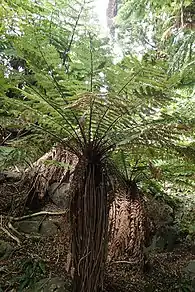 Modern Dicksonia |
|
Lycopodiacidites[1] |
|
|
Spores |
Affinities with the Ophioglossaceae inside Filicopsida. Spores related with modern floor Ferns, that appear on abundant water locations. The Unken Member is considered a more basinal deposit, where Wood and Sporomorph remains are more common. |
|
|
Concavisporites[1] |
|
|
Spores |
Affinities with Gleicheniaceae inside Gleicheniales. Spores that resemble those of the genus Dicranopteris. The Most abundant Spore type found on the Samples, that can be due to the fact that the Genus related is common on large colonies. |
|
|
Cycadopites[1] |
|
|
Pollen |
Affinities with the Cycadopsida inside Cycadales. Pollen related with modern Cycas, arbustive to lower floor plants, relatively abundant, present on various of the measured samples. |
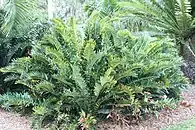 Encephalartos example of Cycad |
|
Circulina[1] |
|
|
Pollen |
Affinities with the Cheirolepidiaceae inside Pinales. Pollen from Arboreal to Arbustive Plants. It is rare on the Samples measured. |
|
Ichnofossils
| Genus | Species | Location | Material | Notes | Images |
|---|---|---|---|---|---|
|
|
Burrowing and track ichnofossils.[30] |
Burrow-like ichnofossils. It has been related to Echiuran annelids,[31] but also from moving and feeding polychaete worms.[32] |
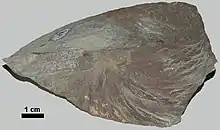 Example of Zoophycos fossil | |
Cephalopoda
| Genus | Species | Stratigraphic position | Material | Notes | Images |
|---|---|---|---|---|---|
|
|
Specimens |
Type Lytoceratidae ammonite |
| |
|
Phymatoceras[2] |
|
|
Specimens |
A Phymatoceratidae ammonite |
|
|
|
Specimens |
| ||
|
Pseudolioceras[2] |
|
|
Specimens |
| |
|
|
Specimens |
| ||
|
Polyplectus[2] |
Polyplectus capellinus |
|
Specimens |
||
|
|
Specimens |
|||
|
Paroniceras[2] |
|
|
Specimens |
||
|
|
Specimens |
A Harpoceratinae ammonite, inside Hildoceratidae. Related with the fauna of the southern Tethys and the Alpine Formations of the Mediterranean. |
| |
|
|
Specimens |
A Dactylioceratinae ammonite, inside Eoderoceratoidea. |
||
|
|
Specimens |
A Dactylioceratinae ammonite, inside Eoderoceratoidea. Related with the Posidonia Shale biota, and the Central European Basin Ammonites. |
| |
|
|
Specimens |
| ||
|
Acrocoelites cf. pyramidalis |
|
Specimens |
A Megateuthididae Belemnitidan. Related with the Posidonia Shale biota, and the Central European Basin Belemnites. Are characterised for its large size. |
| |
Crustacea
| Genus | Species | Stratigraphic position | Material | Notes | Images |
|---|---|---|---|---|---|
|
Gabaleryon[33] |
Gabaleryon sp. 1 |
|
One specimen, part and counterpart |
A Coleiidae Decapodan. Was confussed with Proeryon hartmanni specimens. Although these finds point to some potential for exceptional preservation, the locality was never systematically sampled.[33] It was assigned to the genus Gabaleryon the basis of its ovoid carapace, a transverse groove cutting the axial carina on pleonal terga and an uropodal exopod with curved diaeresis.[33] It shares similarities with Gabaleryon garassinoi and Gabaleryon moorei.[33] |
|
|
Uncina[34] |
Uncina alpina |
|
Single chela |
An Astacidean Decapodan of the family Uncinidae. Reaching large sizes of almost half a meter (39–47 cm), it is among the largest known Jurassic Crustaceans. This large crustacean has been found associated with Ammonite and Bivalve filled Bentos, where probably hunted different kinds of prey.[34] Its large claws would have been perfect for hunting small invertebrates and vertebrates.[34] |
|
Chondrichthyes
| Genus | Species | Stratigraphic position | Material | Notes | Images |
|---|---|---|---|---|---|
|
|
Teeth |
A member of the family Acrodontidae inside Hybodontiformes. A rather rare find related to an Epicontinental setting, where mostly of the remains of the genus are found on nearshore sections. |
| |
|
|
Teeth |
A member of the family Paleospinacidae inside Synechodontiformes. Among the Southernmost finds of the Genus. |
||
|
Sphenodus[19] |
|
|
Teeth |
A member of the family Orthacodontidae inside Synechodontiformes. Among the Southernmost finds of the Genus. |
|
Actinopterygii
| Genus | Species | Stratigraphic position | Material | Notes | Images |
|---|---|---|---|---|---|
|
|
Single Jaw |
Type member of the family Pholidophoridae inside Pachycormiformes. A small sized fish, mostly related to marine deposits, associated with various predatory behaviours, including coeloids and Crocodrylomorphs. |
| |
|
|
40 cm complete Specimen |
Type member of the family Dapediidae inside Halecomorphi. A fish with a skin covered with thick, rhomboid, ganoid scales. Was durophagous, feeding on hard-shelled invertebrates, like mussels and sea urchins, this last ones are abundant on the Urkel Strata |
| |
See also
- List of fossiliferous stratigraphic units in Austria
- Toarcian turnover
- Toarcian formations
- Marne di Monte Serrone, Italy
- Calcare di Sogno, Italy
- Saubach Formation, Austria
- Úrkút Manganese Ore Formation, Hungary
- Posidonia Shale, Lagerstätte in Germany
- Irlbach Sandstone, Germany
- Ciechocinek Formation, Germany and Poland
- Krempachy Marl Formation, Poland and Slovakia
- Lava Formation, Lithuania
- Azilal Group, North Africa
- Whitby Mudstone, England
- Fernie Formation, Alberta and British Columbia
- Whiteaves Formation, British Columbia
- Navajo Sandstone, Utah
- Los Molles Formation, Argentina
- Mawson Formation, Antarctica
- Kandreho Formation, Madagascar
- Kota Formation, India
- Cattamarra Coal Measures, Australia
References
- EBLI, O., DRAXLER, I., KLEIN, P., KODINA, L. A., & LOBITZER, H. (1991). Fazies, Paläontologie und organische Geochemie der Sachranger Schiefer (Untertoarcium) im Mittelabschnitt der Nördlichen Kalkalpen zwischen Isar und Saalach. Jahrbuch der Geologischen Bundesanstalt, 134(1), 5-14.
- Jacobshagen, V. (1965). Die Allgäu-Schichten (Jura-Fleckenmergel) zwischen Wettersteingebirge und Rhein. Wien: Geol. Bundesanstalt
- Ebli, O., Vető, I., Lobitzer, H., Sajgó, C., Demény, A., & Hetényi, M. (1998). Primary productivity and early diagenesis in the Toarcian Tethys on the example of the Mn-rich black shales of the Sachrang Formation, Northern Calcareous Alps. Organic Geochemistry, 29(5-7), 1635-1647.
- Lantos, Z., Vető, I., Földvári, M., & Kovács-Pálffy, P. (2003). On the role of remote magmatic source and intrabasinal redeposition in the genesis of the Toarvian Úrkút Manganese ore, Hungary. Acta Geologica Hungarica, 46(4), 321-340.
- LA VÖRÖS, A. T. T. I. (1991). Hierlatzkalk-a Peculiar Austro-Hungarian Jurassic Facies
- Suan, G., Schlögl, J., & Mattioli, E. (2016). Bio- and chemostratigraphy of the Toarcian organic-rich deposits of some key successions of the Alpine Tethys. Newsletters on Stratigraphy, 49(3), 401–419. doi:10.1127/nos/2016/0078
- Ruebsam, W., Müller, T., Kovács, J., Pálfy, J., & Schwark, L. (2018). Environmental response to the early Toarcian carbon cycle and climate perturbations in the northeastern part of the West Tethys shelf. Gondwana Research, 59, 144-158.
- SCHLOSSER,M.: Zur Geologie des Unterinntales. - Jb. Geol. B.-A., 59, 525-574, Wien 1909
- AIGNER, P.O.: Das Benediktenwandgebirge. - Mitt. Geogr.Ges., 7, 317-421, München 1912
- HAHN, F.F.: Geologie des oberen Saalachgebietes zwischen Lofer und Diesbachtal. - Jb. Geol. R.-A., 63, 1-76, Wien 1913
- SANDER,B.: Ueber bituminöse Mergel. - Jb. Geol. B.-A., 71,135-148, Wien 1921.
- SCHRÖDER,J.: Die Jurassischen Fleckenmergel der bayerischen Alpen. - N. Jb. Min. etc., Beil. Bd., 52, 214-283, Stuttgart 1925
- SCHOTTLER,W.: Die Geologie der westlichen Sachranger Berge in den Chiemgauer Alpen (Hochriß-Laubenstein-Spitzsteingebiet). - N. Jb. Min. etc., Beil. Bd., 72, 46-119, Stuttgart, 1934.
- TOLLMANN,A.: Analyse des klassischen nordalpinen Mesozoikums. Stratigraphie, Fauna und Fazies der Nördlichen Kalkalpen. - 580 S., Wien (Deuticke) 1976.
- Channell, J. E. T., Brandner, R., Spieler, A., & Stoner, J. S. (1992). Paleomagnetism and paleogeography of the northern calcareous Alps (Austria). Tectonics, 11(4), 792–810. doi:10.1029/91tc03089
- Neumeister, S., Algeo, T. J., Bechtel, A., Gawlick, H. J., Gratzer, R., & Sachsenhofer, R. F. (2016). Redox conditions and depositional environment of the Lower Jurassic Bächental bituminous marls (Tyrol, Austria). Austrian Journal of Earth Sciences, 109(2).
- Neumeister, S., Misch, D., Algeo, T.J., Gawlick, Hans.-Jü., Gratzer, R.,Sachsenhofer, R.F., Early diagenesis of organic-rich marls under shifting suboxic to euxinic conditions: The lower Toarcian of the Bächental basin, Marine and Petroleum Geology (2020), doi: https:// doi.org/10.1016/j.marpetgeo.2020.104513.
- Neumeister, S., Gratzer, R., Algeo, T. J., Bechtel, A., Gawlick, H. J., Newton, R. J., & Sachsenhofer, R. F. (2015). Oceanic response to Pliensbachian and Toarcian magmatic events: Implications from an organic-rich basinal succession in the NW Tethys. Global and Planetary Change, 126, 62-83.
- Ebli, O. (1989). Foraminiferen und Coccolithen aus den Lias-Epsilon-Schiefern der Unkener Mulde (Tirolikum, Nördliche Kalkalpen). Mitt. Bayer. Staatsslg. Paläont. hist. Geol, 29, 61-83.
- Szabó-Drubina, M. (1959). Manganese deposits of Hungary. Economic Geology, 54(6), 1078-1094.
- Reinhardt, M., Duda, J. P., Blumenberg, M., Ostertag‐Henning, C., Reitner, J., Heim, C., & Thiel, V. (2018). The taphonomic fate of isorenieratene in Lower Jurassic shales—controlled by iron?. Geobiology, 16(3), 237-251.
- Gesteine, B., Schichten, B., Schichten, S., Schichten, H., & Gosau, K. (1988) An Organic Geochemical Study of Austrian Bituminous Rocks.Jb. Geol. B.-A.ISSN 0016-7800
- Germann, K., & Waldvogel, F. (1971). Mineralparagenesen und Metallgehalte der "Manganschiefer"(unteres Toarcian) in den Allgäu-Schichten der Allgäuer und Lechtaler Alpen. Neues Jahrb. Geol. Palaeontol. Abhandlungen, 139, 316-45.
- Germann, K. (1973). Deposition of Manganese and Iron Carbonates and Silicates in Liassic Marls of the Northern Limestone Alps (Kalkalpen). Ores in Sediments, 129–138. doi:10.1007/978-3-642-65329-2_11
- Beran, A., Faupl, P., & Hamilton, W. (1983). Die Manganschiefer der Strubbergschichten (Nördliche Kalkalpen, Österreich)—eine diagenetisch geprägte Mangankarbonatvererzung. Tschermaks mineralogische und petrographische Mitteilungen, 31(3-4), 175-192.
- Krainer, K., Mostler, H. E. L. F. R. I. E. D., & Haditsch, J. G. (1994). Jurassische Bekkenbildung in den Nördlichen Kalkalpen bei Lofer (Salzburg) unter besonderer Berücksichtigung der Manganerz-Genese (pp. 257-293). na.
- Jacobshagen, D. V.,Schwerd, K., Hornung, T.(2014): Geologische karte von bayern 1:25000. Aviable on:https://www.researchgate.net/profile/Thomas_Hornung/publication/291974505_Geologische_Karte_von_Bayern_125000_Erlauterungen_zum_Blatt_8628_Hochvogel/links/56a8736e08aeded22e378d73.pdf
- G. Mohn, G. Manatschal, O. Müntener, M. Beltrando, E. Masini Unravelling the interaction between tectonic and sedimentary processes during lithospheric thinning in the Alpine Tethys margins Int. J. Earth Sci., 99 (2010), pp. 75-101
- L. Ratschbacher, C. Dingeldey, C. Miller, B.R. Hacker, M.O. McWilliams Formation, subduction, and exhumation of Penninic oceanic crust in the Eastern Alps: time constraints from 40Ar/39Ar geochronology Tectonophysics, 394 (2004), pp. 155-170
- Brongniart, A. 1823. Observations sur les fucoides. Soc. Hist. Natur. Paris, Mem., 1:301-320.
- KOTAKE, N. (1992). Deep‐sea echiurans: possible producers of Zoophycos. Lethaia, 25(3), 311-316.
- Zhang, Li-Jun; Zhao, Zhao (2015). "Complex behavioural patterns and ethological analysis of the trace fossil Zoophycos: Evidence from the Lower Devonian of South China". Lethaia. 49 (2): 275–284. doi:10.1111/let.12146.
- Audo, D., Williams, M., Charbonnier, S., & Schweigert, G. (2017). Gabaleryon, a new genus of widespread early Toarcian polychelidan lobsters. Journal of Systematic Palaeontology, 15(3), 205-222.
- Schweigert, G., Garassino, A., Hall, R. L., Hauff, R. B. & Karasawa, H. 2003. The lobster genus Uncina Quenstedt, 1851 (Crustacea: Decapoda: Astacidea: Uncinidae) from the Lower Jurassic. Stuttgarter Beiträge zur Naturkunde, Serie B, 332, 1-43
.jpg.webp)
.jpg.webp)
